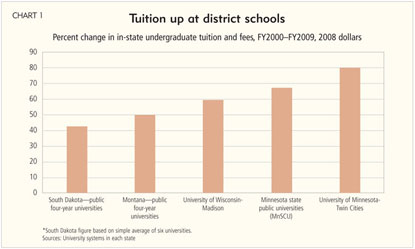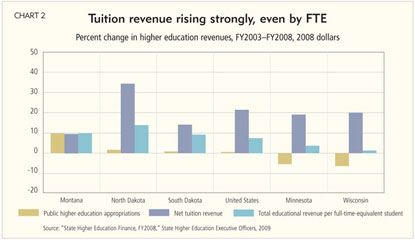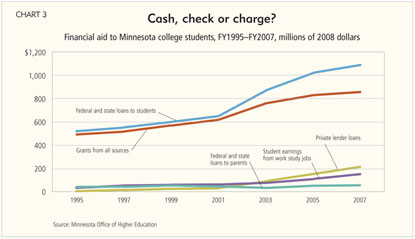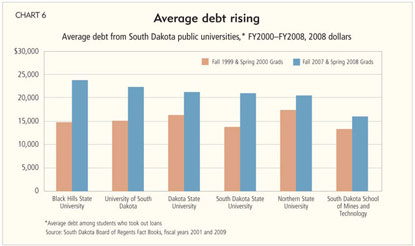OK, class, time for a refresher course on how college got steadily more expensive over the past few decades. Here’s the cheat sheet: more students, higher spending, not-high-enough public appropriations and easy credit.
None of this is particularly tricky, or even new. College tuition and fees, for example, have plotted a steady course upward (see Chart 1). No state, indeed virtually no institution, has escaped the simple fact that tuition and fees for college have skyrocketed beyond almost any other major consumer good.
Higher education officials are often quick to point out that state appropriations have not kept pace with the cost of higher education, which fuels tuition and fee increases. Technically, that’s correct.
But it’s also a half-truth. State appropriations have risen, though more slowly in most states this decade, thanks to bookend recessions. Still, since the late 1970s, almost all district states saw inflation-adjusted increases in state appropriations of at least 26 percent, with South Dakota topping the list at a 50 percent increase.
The exception is Wisconsin, where state appropriations grew a paltry 1.5 percent over this period. However, Wisconsin is also one of a few states where technical colleges are supported by local property tax levies. In fiscal year 2009, tax levies brought in more than $700 million in local appropriations to the state’s 16 technical colleges; that’s an increase of 24 percent in constant dollars since 2000.
There are other caveats, as well. For example, cumulative state appropriations to higher education include direct funding to institutions, but also state-run grant and loan programs for students. Direct funding for individual institutions, therefore, likely reflects a different trend slope. Equally important, adjusted on a full-time-equivalent student basis, state appropriations look more modest of late, given enrollment increases in the district, and have seen a real decline over the past decade in Minnesota and Wisconsin.
Advocates also argue that higher education has become a lower state priority by default, evidenced by the fact that higher education accounts for a steadily declining share of state budgets and that state appropriations make up a declining share of higher ed budgets. For example, state appropriations made up about one-third of the fiscal year 2000 budget for the University of Wisconsin System, which comprises 13 four-year universities (including UW-Madison) and 14 two-year colleges; by 2008, state appropriations had slid below one-quarter of the budget, according to the system’s most recent Fact Book.
That might give the impression that higher education is living on a financial shoestring. If that’s the case, it’s a pretty thick string, because total revenue has risen progressively in higher education. The UW System has kept costs down better than most. Yet total real revenue grew by 11 percent, to $3.9 billion, from 2000 to 2008. Most of the new money comes from just a few sources. For example, student-based revenue in the UW System jumped by 45 percent (inflation-adjusted) to almost $900 million, derived from both higher enrollment and rising tuition. The system also managed to pull in an additional $400 million over this period from gifts, grants and contracts, over half of it from federal sources and much of that for research.
What has resulted is a public higher education model increasingly funded by sources other than state appropriations—namely, students, research contracts and even alumni donation campaigns. Figures from State Higher Education Executive Officers show that public appropriations have been sluggish for much of this decade, while tuition revenue has increased significantly.
Even factoring in rising enrollments, total education revenues per full-time student have outpaced inflation in all district states—significantly in some cases (see Chart 2). Montana has held the lid most tightly on tuition levels of late, the result of recent tuition freezes coupled with higher state appropriations.
Spare a few (thousand) bucks?
Students are dealing with higher costs by seeking more financial aid. In the 2008 school year, students received $143 billion in financial aid, a real increase of 84 percent since 1998, according to the College Board.
The rate at which students seek and receive financial aid varies widely by institution type and even by state. For example, since 1995, at least 80 percent of students in South Dakota’s six public universities have received financial aid, and that figure has inched even higher. That’s well above the national average, currently at 66 percent.
Financial aid demand tends to be lower in the other district states, but all have moved much higher in recent years. In the UW System, the percentage of enrollees receiving any financial aid jumped from 37 percent in 1989 to 66 percent last year.
All of those figures hide still more variation among borrowers in terms of their propensity to seek aid, from what sources and for how much. Though there are exceptions, students attending public two-year schools generally seek less financial aid. They also receive less grant money and take out fewer and smaller student loans because these schools cost less to attend. Financial aid requests and amounts tend to increase at public four-year universities, and levels go higher still for those attending private universities. This typology holds fairly well among institution types, but can vary significantly across states.
Most of the attention regarding financial aid goes to the widely publicized—and criticized—fact that students are becoming increasingly dependent on loans to finance their college education. In 2007, college goers in Minnesota received $2.3 billion in financial aid, more than double the (adjusted) amount in 1997. Loans, most of which come from the federal government, make up the largest portion of the growth (see Chart 3). Breakneck growth in private loans (more than 7,600 percent) over this period has also contributed to the increasing prominence of loans as a source of funding.
Financial aid debates typically focus on a perceived lack of grant aid, based on the fact that the most visible grant program, the federal Pell grant, has persistently shrunk as a percentage of average tuition. (Since 1973, the annual maximum Pell grant has failed to increase even in nominal dollars 14 times, according to the U.S. Department of Education.) But like much else in this debate, it depends on how you read the data. It’s true that grant aid hasn’t generally kept pace with the cost of tuition, which is why student loans are on the rise. But it’s inaccurate to say that grant aid has pulled a disappearing act.
What many don’t recognize is that grant aid has many spigots, including traditional federal and state need-based programs, employer funding, private scholarships and institutional grants, the last of which is the single largest pot of money to help students afford college.
Most of these spigots have been pouring out much more—not less—money over time. From 1997 to 2007, inflation-adjusted grant aid to Minnesota students grew by 74 percent. Institutional grants and tuition discounts accounted for almost half of all grant aid in 2007, at about $417 million, with the other half made up of federal, state and private grant aid.
Institutional aid is doled out in many forms and programs. For example, at the University of Minnesota, the Founders Free Program promises grant and gift assistance equal to tuition and required fees for any state resident who has been admitted as a first-time, full-time student, completes the Federal Application for Financial Student Aid and is eligible for a Pell grant (which indicates financial need, though a student does not necessarily have to be low-income). Started in 2005 and fully implemented last year, the program provides free tuition for nearly 5,000 students—12 percent of undergrads there—according to the university.
Grant aid is likely to continue improving, at least in the short term. Maximum Pell grant awards have risen in each of the past three years, from $4,050 to $5,350 for the current school year. That has meant big bucks for students. With rising enrollment, higher grant amounts and the fact that more students are qualifying for grants courtesy of the recession, it’s estimated that total Pell grants to Minnesota college students will go from about $250 million in the 2008 school year to almost $400 million this school year, according to Department of Education estimates.
In September, the House of Representatives passed a bill that upped the maximum grant again next year to $5,500 and ties the grant max to the cost of living index, plus 1 percent annually, which is expected to push the max to $6,900 by 2019. The Senate was expected to take up the matter by the end of October (after fedgazette deadlines).
Once you factor in grant aid from its multiple sources (institutional, federal, state and private), net tuition costs look much different. Nationwide from fiscal years 2000 to 2009, net tuition costs after grant aid actually fell for two-year schools, though it rose by 17 percent for four-year private schools and by 32 percent for four-year public schools (inflation-adjusted), according to the College Board.
Those figures hide a lot of variation among students in different states because tuition rates fluctuate widely, as does the availability of grant aid. For example, unlike most states, South Dakota has never had a state-based grant program, which is likely one reason for its higher dependence on loan aid. Only about 25 cents of every financial aid dollar for a South Dakota student is grant aid (mostly from federal and institutional sources), compared with 40 cents for Minnesota peers. Much of the gap is due to a Minnesota grant aid program (not to be confused with state appropriations, which go to institutions) that disbursed more than $150 million to students in 2008.
Despite these increases in grant aid, more students at all levels of higher education are borrowing money, and the loan amounts are increasing. Students at two-year colleges in North Dakota were more than twice as likely to take out a student loan in 2008 as they were in 1990 (see Charts 4 and 5). The average loan has increased by about 30 percent (inflation-adjusted) during this period; however, all of that increase has occurred since 2004, according to data from the state university system.
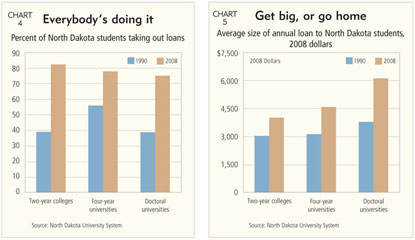
View large charts: Chart 4 Chart 5
Loan + loan = car payment
The growing propensity for and size of student loans has logically caused debt to balloon for Ninth District students.
In the UW System, average debt of resident undergraduates who completed a bachelor’s degree and who borrowed while in college hit $22,400 in 2008, according to system figures. That’s an 85 percent real increase from 1989. In the 2007 graduating class from Minnesota public universities, 77 percent carried student loans averaging $23,600, according to the Minnesota Office of Higher Education. Their monthly payment over 10 years was $270.
But state averages gloss over differing debt levels among even fairly similar institutions. Among South Dakota’s six universities, for example, both average debt and growth of debt over time have varied widely (see Chart 6).
Despite the surge in borrowing, not all students go into debt for college. Nationwide a little over half of those graduating with associate degrees in 2007–08 did so with no debt; 34 percent of those leaving with baccalaureates did likewise, and two-thirds of all graduates at all levels left with less than $20,000 in debt. But all of those figures are worsening from a student-finance standpoint.
The uniqueness of U.S. higher education, including institutions in the Ninth District, is that it is not a unified system; rather, it has evolved and expanded into a multitude of programs—public and private, profit and nonprofit—of various length, quality and price points. As one source put it, “It’s available to everyone, if you can figure out how to [pay for] access.”
Ron Wirtz is a Minneapolis Fed regional outreach director. Ron tracks current business conditions, with a focus on employment and wages, construction, real estate, consumer spending, and tourism. In this role, he networks with businesses in the Bank’s six-state region and gives frequent speeches on economic conditions. Follow him on Twitter @RonWirtz.



